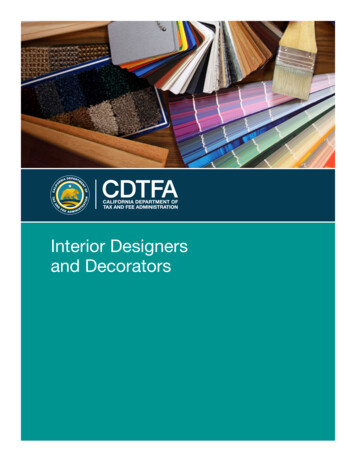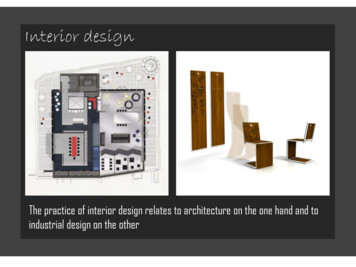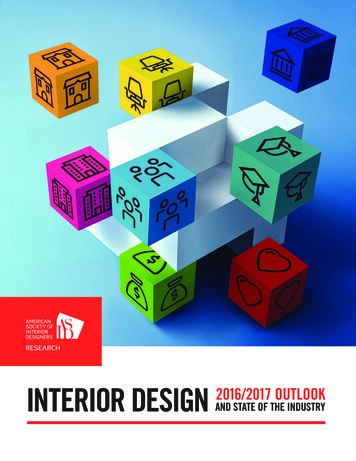
Transcription
Interior designers:8Photo courtesyof the NationalKitchenand Bath AssociationOccupationalOutlookQuarterlyFall 2005
Sprucing up spaceby Jill N. LaceyDo you rearrange furniture as a hobby? Do you know 10 shades of the color orange?Do you idolize the interior designers on TV like other people revere movie stars?If you answered yes to any of those questions, you might have a future as an interior designer. But interior designers’ knowledge extends beyond color swatches and furnitureplacement. Designers draw upon numerous disciplines to enhance the function, safety, andaesthetics of interior spaces. These experts help to make their clients’ living and workingspaces more appealing by combining colors, textures, furniture, lighting, and space.And the types of projects that designers work on are more diverse than the livingspaces depicted on television or in magazines. Designers are involved in planning theinterior spaces of almost every kind of building, including offices, restaurants, andschools. Interior designers help to improve these spaces for specific purposes, such as to boost worker productivity, to attract a wealthy clientele, or to provide an environment conducive to learning.This article describes the work of interior designers. Keep readingto learn about interior designers’ typical job duties, earnings, employment, and outlook. You’ll also find out how to train for, enter, andadvance in the design field and discover resources for getting moreinformation.Jill N. Lacey is an economist in the Office of Occupational Statistics and EmploymentProjections, BLS, (202) 691-5806.Fall 2005 Occupational Outlook Quarterly9
The designer’s workPhoto courtesy of the National Kitchen and Bath AssociationInterior design work evolved from interior decorating—choosing a style and a color palette and then selectingcomplementary furniture, floor and window coverings,artwork, and lighting.Decorating is still an important part of many interiordesigners’ work, but now the work is more technical.Designers increasingly are becoming more involved indesigning details, such as built-in bookshelves, or planning the layout of building renovations, including theInterior designers apply their technical knowledge to createappealing spaces for clients.10placement of windows, escalators, and walkways. Theyread blueprints, work with architects and building inspectors, and follow regulations. Interior designers sometimessupervise assistants who carry out the designer’s creations and perform administrative tasks, such as reviewing catalogs and ordering samples.Design process. Nearly all projects, regardless of thetype of space that they involve, follow the same designprocess. The first step in developing a new design isto determine the client’s needs. This step is known asprogramming. An interior designer usually meets faceto-face with the client to find out how the space willbe used—when remodeling a kitchen, for example, thedesigner might inquire about a family’s cooking habits.The designer also interviews the client about style anddesign preferences and about budget size. The designerOccupational Outlook Quarterly Fall 2005also visits the space to inventory existing furniture andequipment and to identify the space’s positive attributesand potential design problems.Next, the designer formulates a design plan and costestimate based on the client’s goals and budget. Thedesigns usually are created using computer-aided design(CAD) software, which provides a detailed layout and allows for easy corrections. The designer presents it to theclient for review and then revises the plan after receivingthe client’s input.After the plan is approved, the designer begins specifying required items, such as furniture, lighting,flooring, and wall coverings. The designer alsomight need to prepare and submit drawings for review by an architect and approval by a constructioninspector to ensure that the design meets buildingcodes. If a project requires structural work, thedesigner works with an architect or an engineer todesign those elements.Most designs also require technical work,such as lighting, plumbing, or electrical wiring, thatneeds to be completed by professionals. When aproject requires technical work, the designer chooses qualified contractors and writes work contracts.In the final steps of the design process, thedesigner develops a timeline for the project andensures that it is completed on time. The designermight coordinate work schedules for contractorsand oversee installation to make sure that it is doneproperly. After the project is complete, the designerfollows up with the client and corrects problems.Designer jobs. Many designers run their own businesses; they may devote considerable time to meetingwith clients and contractors, developing new businesscontacts, examining equipment and space needs, andattending to business matters.Designers who work in furniture or home-and-gardenstores have different responsibilities. They offer theirdesign services while selling store merchandise and oftenhelp other interior designers by suggesting styles and color schemes or suitable accessories and lighting. However,in-store designers rarely visit clients’ spaces, and they arelimited to recommending their store’s products.Design specialties. Although most interior designersdo many kinds of projects, some specialize in one areaof interior design. Some designers specialize in a typeof building space—usually residential or commercial—
while others concentrate on a specific design field, suchself-employed designers also are under pressure to findas healthcare or education.new clients.Still others focus on a particular design element. Themost common of these are lighting, kitchen and bath, andcloset designs. Acoustics and noise abatement, security,Style by numbers: Interior designelectronics and home theaters, home spas, and indoorjobs and what they paygardens are also popular specialties.Interior designers work for many types of employers;Three other areas of design that are becoming insome work for themselves. And whom they work forcreasingly popular are ergonomic design, “elder design,”affectshow much they earn.and environmental, or “green,” design. Ergonomic designEmployment.Interior designers held 46,360 wageinvolves designing workspaces that emphasize goodand-salary jobs in May 2004. About 31 percent of theseposture and minimize muscle strain. Elder design is theinterior designers worked in specialized design services.planning of interior space to aid the movement of the elAnother 19 percent worked in engineering and relatedderly and people with disabilities. Green design involveschoosing materials that are hypoallergenic, chemical free, services. Other interior designers provided design services in furniture and home furnishing stores, buildingenergy efficient, or made from renewable resources.Working environment. Most designers transact busi- materials and supplies dealers, and residential buildingconstruction companies.ness in their own offices or in clients’ homes or offices.In addition to wage-and-salary workers, there areThey also might need to travel to other locations, such asthousandsof self-employed interior designers. Manyshowrooms, design centers, and manufacturing facilities.interiordesignersalso perform freelance work along withMany designers use the Internet to form internationalholding a salaried job in design or in another occupation.design teams, serve a geographically dispersed clientele,and purchase supplies fromaround the world.Median earnings for interior designers in selected industries,Interior designers who areMay 2004employed50000by large corporations or design firms generally 44,740work standard 9-to-5, 40-hour42,000workweeks in well-lit, com40000fortable settings. Designers37,75037,480who work in smaller design33,360consulting firms or who freelance30000generally are hired on acontract basis. They frequentlyadjust their workdays to suittheir clients’ schedules and20000deadlines, meeting with clientsin the evenings or on weekendswhen necessary. Consultantsand self-employeddesigners10000usually work longer hours and,often, in smaller environments.Interior designers may0work under stressful sidentialto meet deadlines, stay withinengineering, anddesignstoresbuildingfurnishingsbudgets, and please clients.related servicesservicesconstructionstoresTo maintain a steady income,Fall 2005 Occupational Outlook Quarterly11
Photo courtesy of the National Kitchen and Bath Associationage, or charge a flat fee for an entireproject. Designers who use specialtycontractors usually earn a percentage ofthe contractor’s earnings on a project inreturn for hiring the contractor.Job prospectsAlthough interior designers use computer-aided designprograms, they still need basic mathematics skills.12Earnings. In May 2004, median annual earningsfor wage-and-salary interior designers were 40,670.(Median earnings are the point at which half of interiordesigners earned more than this amount and half earnedless.) The highest earning 10 percent made more than 71,220, and the lowest earning 10 percent made lessthan 23,440. Earnings varied by industry. The chart onthe previous page shows median earnings of interior designers in the industries in which they most often work.Interior designers’ salaries vary by specialty, type ofemployer, experience, and other factors. Among salariedinterior designers, those in large, specialized design andarchitectural firms usually have the highest and moststable earnings. Interior designers working in retail storesusually make less, and their earnings can be irregularbecause they work on commission.For residential design projects, interior designers whoare self-employed or who work in smaller firms usuallyearn a per-hour consulting fee, plus a percentage of thetotal cost of furniture, lighting, artwork, and other designelements. For commercial projects, designers mightcharge a per-hour consulting fee, charge by square foot-Occupational Outlook Quarterly Fall 2005Employment of interior designers is projected to growfaster than the average for all occupations through 2012.Workers entering the occupation for the first time areexpected to fill 20,000 openings between 2002 and 2012.An expanding economy, growing homeowner wealth,and a rising interest in interior design are expected to increase demand for designers. However, interior designersare expected to face keen competition for available positions. People who have formal training in interior designand who are creative and persistent will be best able toestablish and maintain a career in this occupation.As the economy grows, more private businessesand consumers are expected to seek interior designers’services. But some people consider design services aluxury expense, which may make these services subject to fluctuations in the economy. For example, a sloweconomy that causes decreases in consumer and businessincome and spending can negatively affect employmentof interior designers.Nevertheless, demand for interior design servicesis expected to be strong. This is especially true in thehealthcare industry because more facilities are expectedto be needed to accommodate the aging population.Designers can make these facilities as comfortable andas much like home as possible for patients. Demand forinterior design services in the hospitality industry—including hotels, resorts, and restaurants—also is projectedto be high because of an expected increase in tourism.Recent increases in homeowner wealth and thegrowing popularity of home-improvement televisionprograms have boosted demand for residential designservices. Many homeowners use their home equity tofinance expansion and remodeling projects—and associated design services expenses. Many homeowners alsohave requested design help in adding year-round, outdoorliving spaces.Along with piquing interest in interior design services, however, home-improvement television programs
have spurred a trend in do-it-yourself design. The prevalence of discount furniture stores also contributes to thistrend, which could hamper job growth for designers. Butpeople who do their own projects often hire a designerfor initial consultations, even if they purchase and installthe design elements themselves.Specialization allows some interior designers tocreate a niche for themselves in an increasingly competitive market. The demand for kitchen and bath design isgrowing in response to the increasing demand for homeremodeling. Designs using the latest technology, such ashome theaters and security systems, are expected to beespecially popular. And the increasing demand for homespas, indoor gardens, and outdoor living spaces is expected to continue.The previously mentioned specialties of ergonomicand green design also are expected to be in demand. Ergonomic design has gained in popularity with the growthin the elderly population and in requirements for workplace safety. Increases in the awareness of environmentalquality and in the number of people who have allergiesand asthma are expected to boost demand for greendesign.Designing a careerPreparing for, entering, and advancing in the field ofinterior design requires a combination of skills, training,professional affiliation, and relevant experience.Skills and abilities. Interior designers must be creative, imaginative, and persistent. Because tastes in stylecan change quickly, designers need to be well read, opento new ideas and influences, and quick to react to changing trends. Problem-solving skills and the ability to workwell independently and under stress are important. Peoplein this field need self-discipline to start projects on theirown, to budget their time, and to meet deadlines andproduction schedules.Communication skills, too, are essential for interiordesigners. For example, designers frequently collaboratewith architects, electricians, and building contractors toensure that their designs are safe and meet constructionrequirements. Designers also must be able to communicate their ideas in writing.In addition, designers need basic skills in businessand mathematics. Business skills are important when or-dering samples and supplies, billing vendors, and writingcontracts, proposals, and budgets. Math skills are usedwhen measuring space and calculating the amount—andcost—of materials needed.Some required skills are specific to the work of interior designers. For example, designers should be familiarwith CAD software and be able to read blueprints, understand building and fire codes, and know how to makespace accessible for disabled people.Training and licensure. To acquire the skills thatthey need, interior designers are encouraged to pursueeducation after high school. Training programs are available from professional design schools or colleges anduniversities and usually take 2 to 4 years to complete.Graduates of 2- and 3-year programs earn certificatesor associate degrees in interior design and, upon graduation, normally qualify as assistants to interior designers.Graduates of bachelor’s degree programs often enter intoa formal design apprenticeship program, or they work onsmaller projects or under supervision as they gain experience. Basic coursework includes instruction in CADsoftware, drawing, perspective, spatial planning, colorand fabrics, furniture design, architecture, ergonomics,ethics, and psychology.The National Association of Schools of Art and Design accredits about 250 postsecondary institutions thathave programs in art and design. Most of these schoolsaward a bachelor’s or associate degree in interior design.Applicants to these schools may be required to submitsketches and other examples of their artistic ability.The Foundation for Interior Design EducationResearch also accredits postsecondary interior designprograms. In July 2005, there were 137 foundationaccredited professional programs in interior design,located primarily in schools of art, architecture, and homeeconomics.A national licensing exam for interior designers isadministered by the National Council for Interior DesignQualification. To be eligible to take the exam, applicantsmust have at least 2 years of postsecondary educationin design and a total of 6 years of combined educationand experience in interior design. After candidates havepassed the qualifying exam, they receive the title of certified, registered, or licensed interior designer, dependingon the State. Continuing education is required for maintaining licensure in some States.Twenty-four States, the District of Columbia, andFall 2005 Occupational Outlook Quarterly13
14Puerto Rico require registration or licensure of interiordesigners. Prospective designers working in these locations usually enter a 1- to 3-year internship to gain experience after formal training but before taking a nationallicensing examination or joining a professional association. Designers in States that do not require the exammay opt to take it as proof of their qualifications.Professional affiliation. Because registration andlicensure are not mandatory in all States, many interiordesigners seek membership in a professional associationto indicate their qualifications and professional standing.The American Society of Interior Designers is the largest professional association for interior designers in theUnited States. Interior designers qualify for membershipif they have completed at least a 2-year program and havework experience. Student memberships also are available.In addition to national licensure and membership ina professional association, optional certifications inkitchen and bath design are available from the NationalKitchen and Bath Association. The association providestraining seminars, some of which culminate in exams forthree different levels of certification.Gaining experience. In the highly competitive fieldof interior design, gaining on-the-job experience througha formal internship is critical to securing a permanentposition. Most interns work in design or architecturefirms under the supervision of an experienced designer.But interns also may gain experience working as in-storedesigners in furniture or home-improvement stores.To secure an internship or full-time design position,candidates usually interview with a senior designer ata firm. Most interviews include candidates presentingthe best design projects in their portfolio, followed by aquestion-and-answer session with the interviewer. Successful candidates often present their work as if they werepitching their ideas to a client. With their presentation,candidates should clearly and concisely state what therequirements or goals of the projects are, how the designsmeet those goals, and how they solve various designproblems. As with most interviews, rehearsing ahead oftime improves the chances of getting the job.The National Council for Interior Design Qualification offers the Interior Design Experience Program tohelp entry-level interior designers get work experience.Program participation is voluntary, but some employersmight require it of applicants for full-time jobs. Successfully completing the program also makes it easier to fulfill experience requirements for some types of licensure.Occupational Outlook Quarterly Fall 2005Participation in the program usually takes 2 to 3years, depending on the level of education that a designerhas completed. Program participants must secure theirown job and work with a supervisor and mentor to meetrequirements in six competency areas: Programming,schematic design, design development, contract documents, contract administration, and professional practice.Experience in competency areas is gained by workingdirectly on projects, observing others work, and attending lectures and seminars. From time to time, participants also submit completed work logs to the council forreview and approval.Career advancement. Before they can advance tohigher positions, entry-level interior designers receiveon-the-job training. Normally, they need 1 to 3 years oftraining. During this time, these designers usually have toperform small tasks, including administrative ones, whilelearning the basics of design.Experienced designers in large firms may advance tochief designer, design department head, or other supervisory positions. Some experienced designers open theirown firms or specialize in one aspect of interior design.Other designers leave the occupation to become teachersin design schools or in colleges and universities. Manyfaculty members continue to consult privately or operate small design studios to complement their classroomactivities.For more informationTo learn more about becoming an interior designer, visityour local library or career counselor. Look for books,trade journals, and other resources about interior designand its specialties.One career resource available in most libraries andcounseling offices is the Occupational Outlook Handbook. The Handbook describes the job duties, workingconditions, training requirements, earnings, outlook, andmore for hundreds of occupations. Among the occupations covered in the Handbook are some that, like interiordesigners, involve the design or arrangement of objectsto enhance their appearance and function. These includearchitects, artists and related workers, and landscapearchitects. The Handbook also describes other types ofdesigners, such as industrial designers, graphic designers,and fashion designers. You may also access the Handbookonline at www.bls.gov/oco.
Other BLS information available online includesoccupational profiles. For the most recent data on interiordesigners, see www.bls.gov/oes/current/oes271025.Professional organizations also provide informationabout careers and training in interior design. For generalinformation, see www.careersininteriordesign.org.For information about degree, continuing education,and licensure programs in interior design and interiordesign research, contact:American Society of Interior Designers608 Massachusetts Ave. NE.Washington, DC 20002-6006(202) 546-3480www.asid.orgFor a list of schools with accredited bachelor’s programs in interior design, contact:Foundation for Interior Design Education Research146 Monroe Center NW., Suite 1318Grand Rapids, MI 49503-2822(616) 458-0400www.fider.orgFor general information about art and design and alist of accredited college-level programs, contact:National Association of Schools of Art and Design11250 Roger Bacon Dr., Suite 21Reston, VA 20190-5248(703) 437-0700nasad.arts-accredit.orgFor information about State licensing requirementsand the Interior Design Experience Program, contact:National Council for Interior Design Qualification1200 18th St. NW., Suite 1001Washington, DC 20036-2564(202) 721-0220www.ncidq.orgFor information on careers, continuing education,and certification programs in the specialty of residentialkitchen and bath design, contact:National Kitchen and Bath Association687 Willow Grove St.Hackettstown, NJ 07840-1713Toll-free: 1 (800) 843-6522www.nkba.org/student15Fall 2005 Occupational Outlook Quarterly
Interior design work evolved from interior decorating— choosing a style and a color palette and then selecting complementary furniture, floor and window coverings, artwork, and lighting. Decorating is still an important part of many interior designers’ work, but now the work is mor










